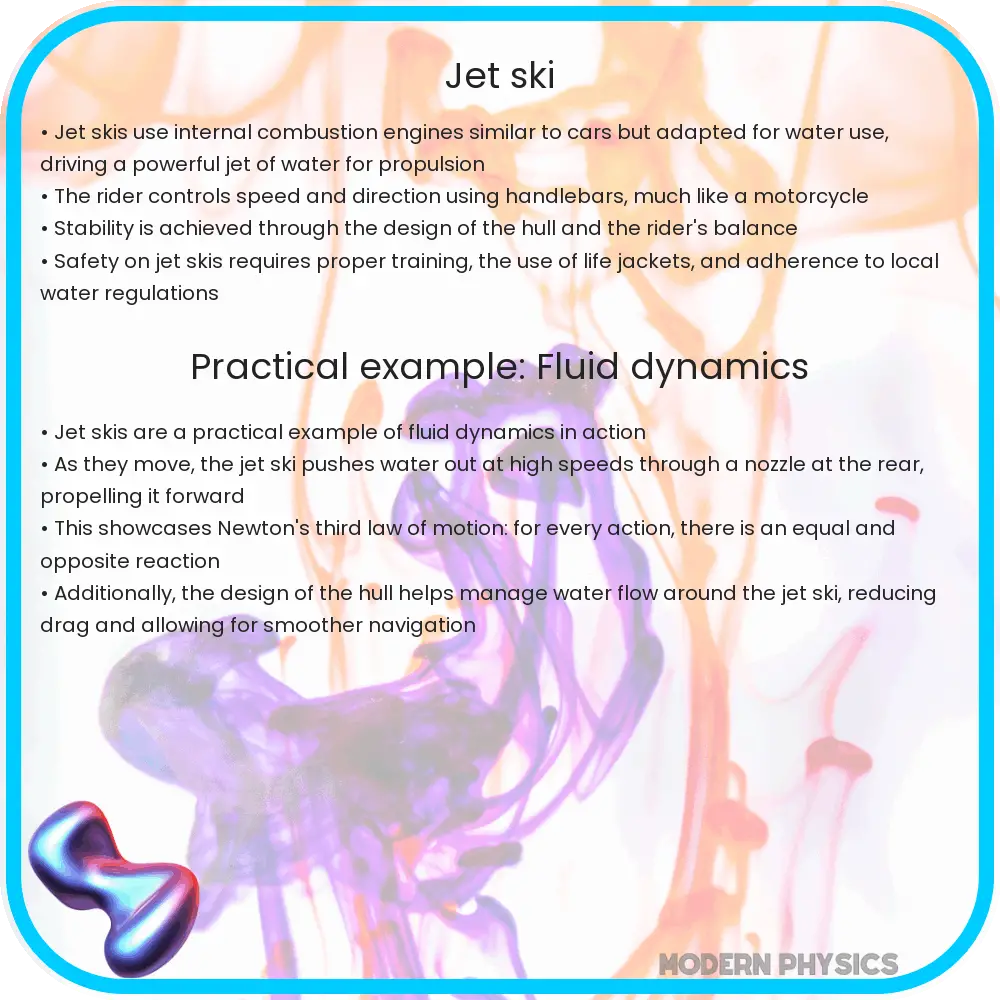Explore the excitement of jet skiing with insights into speed, maneuverability, kinematics, advanced techniques, and environmental impacts.

Jet Ski Thrills: Exploring Speed, Maneuverability, and Kinematics
Jet skiing is an exhilarating water sport that combines high speed, sharp maneuverability, and the thrilling dynamics of kinematics. It offers an adrenaline-pumping experience, making it a favorite among water sports enthusiasts. This article delves into the science behind the speed, maneuverability, and kinematic principles that make jet skiing such a thrilling adventure.
Understanding Jet Ski Speed
Speed is a critical aspect of jet skiing. It is not just about how fast the jet ski can travel, but also about how the watercraft accelerates and maintains its velocity. The speed of a jet ski depends on several factors, including engine power, watercraft design, and the rider’s skill. Modern jet skis are equipped with powerful engines that can generate significant horsepower, propelling the watercraft at impressive speeds. The design of the hull also plays a crucial role in determining how efficiently a jet ski cuts through water, reducing drag and allowing for higher speeds.
Maneuverability: The Art of Navigation
Maneuverability is another key aspect that enhances the thrill of jet skiing. It refers to the ability of the jet ski to change direction quickly and efficiently. This agility is achieved through a combination of design elements and rider input. The shape of the jet ski, along with its center of gravity, affects how it responds to steering. Skilled riders use their body weight and balance to aid in steering, executing sharp turns and navigating through waves with precision.
Kinematics: The Science of Motion
Kinematics, the branch of physics that deals with the motion of objects, is at the heart of understanding jet ski dynamics. It involves analyzing the motion of the jet ski in terms of displacement, velocity, and acceleration. The interplay of these factors, combined with external forces like water resistance and gravity, dictates the jet ski’s behavior on water. For instance, the lift generated by the speed of the jet ski can lead to a phenomenon known as “planing,” where the jet ski skims the water’s surface, reducing drag and enhancing speed.
Moreover, the application of Newton’s laws of motion, particularly the third law (for every action, there is an equal and opposite reaction), is evident in jet skiing. The jet ski’s engine expels water at high speeds through a jet nozzle, creating a thrust that propels the watercraft forward. This action-reaction mechanism is fundamental to the jet ski’s ability to accelerate and maneuver.
In conclusion, jet skiing is a perfect blend of speed, maneuverability, and kinematics, offering a unique and thrilling experience on the water. Understanding the science behind these elements not only enhances the enjoyment of the sport but also contributes to safer and more skilled riding.
The Role of Rider Skill and Safety in Jet Skiing
The rider’s skill plays a pivotal role in maximizing the thrill and safety of jet skiing. Skilled riders are adept at controlling speed, executing maneuvers, and reacting to changing water conditions. They understand the importance of balance and weight distribution, which are crucial for maintaining stability and executing turns. Additionally, safety is paramount in jet skiing. Riders must be aware of their surroundings, adhere to safety regulations, and wear appropriate gear, such as life jackets and helmets.
Advanced Techniques and Environmental Considerations
Beyond basic riding skills, advanced techniques can greatly enhance the jet skiing experience. These include mastering jumps, wave riding, and high-speed turns. Advanced riders learn to read the water conditions, anticipate waves, and use them to perform aerial maneuvers. However, with increased skill comes greater responsibility. Riders must always be conscious of the environment and ensure their activities do not harm marine life or disrupt ecosystems. This includes avoiding sensitive areas and respecting local wildlife.
Technological Advancements in Jet Ski Design
Technological advancements have significantly improved jet ski performance and safety. Modern jet skis come equipped with features like electronic fuel injection for better engine performance, braking systems for improved safety, and ergonomic designs for greater comfort and control. These innovations not only enhance the rider’s experience but also contribute to environmental sustainability, with newer models offering more fuel-efficient engines and reduced emissions.
Maintaining and Servicing Your Jet Ski
Regular maintenance and servicing are crucial for safe and optimal jet ski performance. This includes routine checks of the engine, hull, and jet pump, as well as timely repairs and replacements of worn-out parts. Proper maintenance ensures longevity of the jet ski and helps prevent accidents due to equipment failure. Riders should also stay informed about the latest safety recalls and updates from manufacturers.
Conclusion
Jet skiing offers an unparalleled combination of excitement, skill, and interaction with nature. The thrill of speed and maneuverability, underpinned by the principles of kinematics, makes it a unique water sport. However, it is the rider’s responsibility to balance this thrill with safety and environmental awareness. Advanced techniques and technological advancements continuously push the boundaries of what is possible on a jet ski, while regular maintenance ensures a safe and enjoyable experience. Ultimately, jet skiing is not just about the rush of gliding over water; it’s about respecting and harmonizing with the marine environment, understanding the mechanics behind the sport, and continuously learning and improving as a rider. This symbiotic relationship between the rider, the machine, and the water is what truly defines the jet ski experience.
